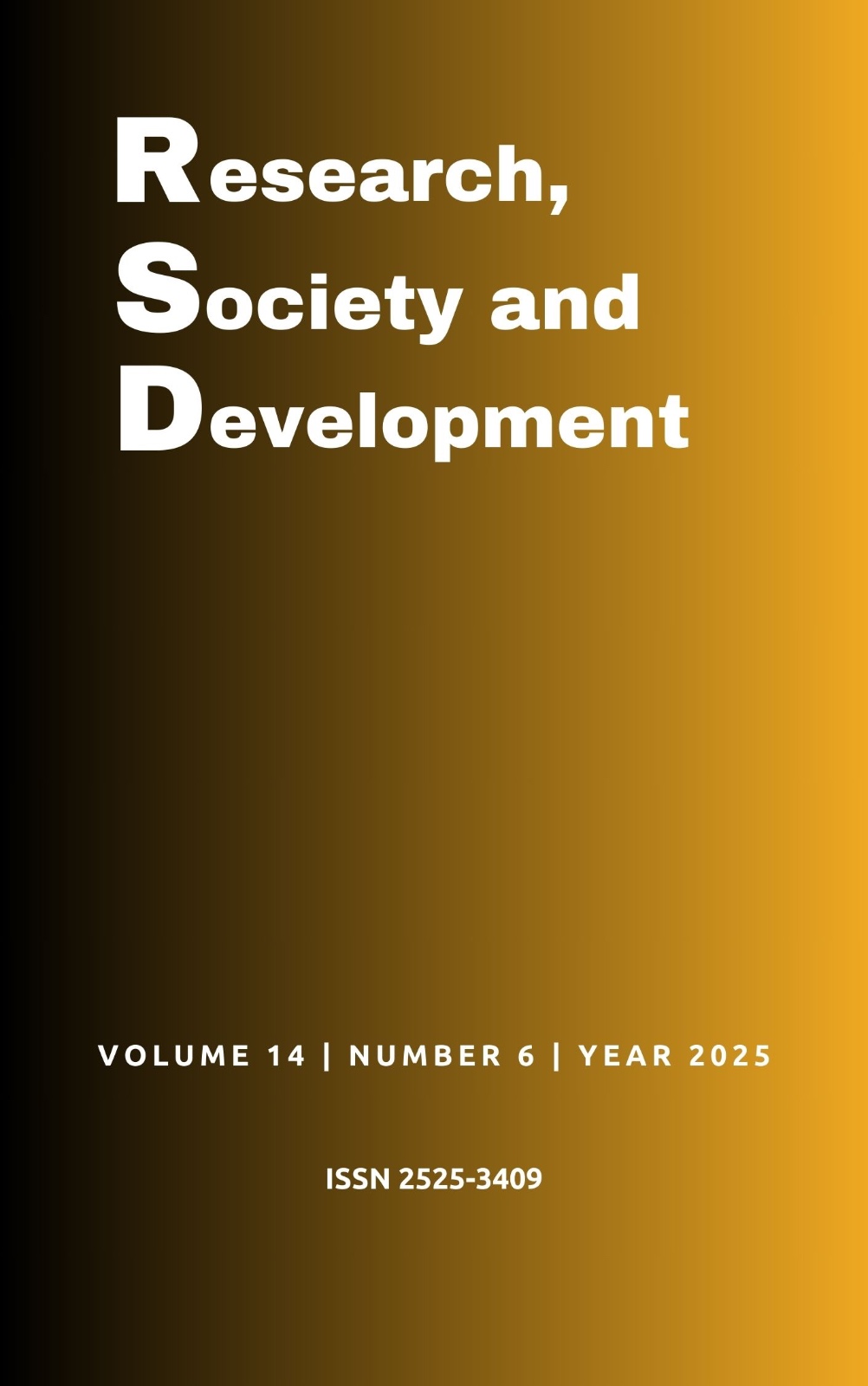Narcolepsia pós-COVID 19, um relato de caso
DOI:
https://doi.org/10.33448/rsd-v14i6.48848Palavras-chave:
Narcolepsia, COVID-19, Infecção, Insônia, Sono REM.Resumo
Objetivo: O objetivo do presente artigo foi relatar o caso de uma adolescente que desenvolveu narcolepsia após infecção pela COVID-19 e não houve outras infecções que justificassem o caso. Metodologia: as informações foram obtidas através de revisão do prontuário, registro dos preceitos diagnósticos e revisão da literatura. Relato de caso: Paciente B.M.C, Gênero feminino, 16 anos, apresentou-se à clínica devido episódios de narcolepsia. Considerações finais: o caso relatado e publicações levantadas trazem luz à possibilidade de a infecção pela COVID-19 também causar narcolepsia, sendo este um novo meio de desencadeamento desta patologia.
Referências
Alóe, F., Alves, R. C., Araújo, J. F., Azevedo, A., Bacelar, A., Bezerra, M., Bittencourt, L. R. A., Bustamante, G., Cardoso, T. A. M. de O., Eckeli, A. L., Fernandes, R. M. F., Goulart, L., Pradella-Hallinan, M., Hasan, R., Sander, H. H., Pinto Jr., L. R., Lopes, M. C., Minhoto, G. R., Moraes, W., & Moreira, G. A. (2010). Diretrizes brasileiras para o diagnóstico de narcolepsia. Brazilian Journal of Psychiatry. 32(3), 294–305.
Bayon V, Damien Léger D, Philip P. (2009). Socio-professional handicap and accidental risk in patients with hypersomnias of central origin. Sleep Med. 13(6), 421-6.
Brundin, L., Björkqvist, M., Petersén, Å. & Träskman-Bendz, L. (2007). Reduced orexin levels in the cerebrospinal fluid of suicidal patients with major depressive disorder. European Neuropsychopharmacology. 17(9), 573–9.
Chemelli, R. M., Willie, J. T., Sinton, C. M., Elmquist, J. K., Scammell, T., Lee, C., Richardson, J. A., Williams, S. Clay., Xiong, Y., Kisanuki, Y., Fitch, T. E., Nakazato, M., Hammer, R. E., Saper, C. B., & Yanagisawa, M. (1999). Narcolepsy in orexin Knockout Mice. Cell. 98 (4), 437–51.
Complex HLA-DR and -DQ Interactions Confer Risk of Narcolepsy-Cataplexy in Three Ethnic Groups. (2001). The American Journal of Human Genetics. 68(3), 686–99.
Dauvilliers, Y. & Arnulf, I. (2008). Narcolepsie avec cataplexie. Revue Neurologique. 164(8-9), 634-45.
de Almeida Andrade, P. H., Rodrigues Morais de Oliveira, M., Diniz Morais, S. M., Aguiar Gripp Junior, F. & Gonçalves Nobre, A. F. (2024). Doenças Autoimunes: Atualização no Diagnóstico e Tratamento em Clínica Geral. Brazilian Journal of Implantology and Health Sciences. 6(10), 1999–2009.
Franceschini, C., Pizza, F., Cavalli, F. & Plazzi, G. (2021). A practical guide to the pharmacological and behavioral therapy of Narcolepsy. Neurotherapeutics. 18(1), 6-19. doi: 10.1007/s13311-021-01051-4.
Frauscher, B., Ehrmann, L., Mitterling, T., Gabelia, D., Gschliesser, V., Brandauer, E., Poewe, W., & Högl, B. (2013). Delayed Diagnosis, Range of Severity, and Multiple Sleep Comorbidities: A Clinical and Polysomnographic Analysis of 100 Patients of the Innsbruck Narcolepsy Cohort. Journal of Clinical Sleep Medicine.
Goldman, L., & Schafer, A. I. (2019). Goldman-Cecil medicine. Elsevier, Inc. 6598-6600.
Heydendael, W., Sengupta, A., Beck, S. & Bhatnagar, S. (2014). Optogenetic examination identifies a context-specific role for orexins/hypocretins in anxiety-related behavior. Physiology & Behavior. 130, 182–90.
Huang, Y.-S., Guilleminault, C., Lin, C.-H., Chen, C.-H., Chin, W.-C. & Chen, T.-S. (2018). Multiple sleep latency test in narcolepsy type 1 and narcolepsy type 2: A 5-year follow-up study. Journal of Sleep Research. 27(5), e12700.
Ito, E. & Inoue, Y. (2015). [The International Classification of Sleep Disorders, third edition. American Academy of Sleep Medicine. Includes bibliographies and index. Nihon Rinsho. Japanese Journal of Clinical Medicine. 73(6), 916–23.
Jameson, J. (2019). Harrison’s manual of medicine. (20th ed.). McGraw-Hill, Ed. 740-5.
Kawai, M., O’Hara, R., Einen, M., Lin, L. & Mignot, E. (2015). Narcolepsy in African Americans. Sleep. 38(11), 1673–81.
Kornum, B. R. & Jennum, P. (2020). The case for narcolepsy as an autoimmune disease. Expert Review of Clinical Immunology, 16(3). https://doi.org/10.1080/1744666X.2020.1719832.
Medeiros, M. R. B. & Silva, R. C. L. M. & Almondes, K. M., K. (2022). Narcolepsia na Infância: A Atuação Multidisciplinar com a Psicologia do Sono do Diagnóstico ao Tratamento em um Relato de Caso. Psicologia: Ciência E Profissão, 42.
https://doi.org/10.1590/1982-3703003243224. https://www.scielo.br/j/pcp/a/yzpGRdW63cMNt78CFKW7cMm/abstract/?lang=pt.
Morgadinho, F., Coelho, S., Motta Elias, R., Pradella-Hallinan, M., Rita, L., Bittencourt, A. & Tufik, S. (2007). Revisão da Literatura Narcolepsia Narcolepsy. Arch. Clin. Psychiatry (São Paulo) 34(3). https://doi.org/10.1590/S0101-60832007000300005.
Morgenthaler T I, Kapur V K, Brown T, Swick T J, Alessi C, Aurora R N, Boehlecke B, Chesson A L Jr, Friedman L, Maganti R, Owens J, Pancer J, Zak R. (s.d.). Standards of Practice Committee of the American Academy of Sleep Medicine. Practice parameters for the treatment of narcolepsy and other hypersomnias of central origin. Sleep, 30(12), 1705-11.
Pereira A. S. et al. (2018). Metodologia da pesquisa científica. [free e-book]. Editora UAB/NTE/UFSM.
Quaedackers, L., Pillen, S. & Overeem, S. (2021). Recognizing the Symptom Spectrum of Narcolepsy to Improve Timely Diagnosis: A Narrative Review. Nature and Science of Sleep. 13, 1083–96.
Roya, Y., Farzaneh, B., Mostafa, A-D., Mahsa, S. & Babak, Z. (2023). Narcolepsy following COVID‐19: A case report and review of potential mechanisms. Clinical Case Reports. 1 (6), e7370. doi: 10.1002/ccr3.7370. https://pmc.ncbi.nlm.nih.gov/articles/PMC10213711/
Downloads
Publicado
Edição
Seção
Licença
Copyright (c) 2025 Rodrigo Henrique Nogueira Mamédio; Rafael Vinhal da Costa

Este trabalho está licenciado sob uma licença Creative Commons Attribution 4.0 International License.
Autores que publicam nesta revista concordam com os seguintes termos:
1) Autores mantém os direitos autorais e concedem à revista o direito de primeira publicação, com o trabalho simultaneamente licenciado sob a Licença Creative Commons Attribution que permite o compartilhamento do trabalho com reconhecimento da autoria e publicação inicial nesta revista.
2) Autores têm autorização para assumir contratos adicionais separadamente, para distribuição não-exclusiva da versão do trabalho publicada nesta revista (ex.: publicar em repositório institucional ou como capítulo de livro), com reconhecimento de autoria e publicação inicial nesta revista.
3) Autores têm permissão e são estimulados a publicar e distribuir seu trabalho online (ex.: em repositórios institucionais ou na sua página pessoal) a qualquer ponto antes ou durante o processo editorial, já que isso pode gerar alterações produtivas, bem como aumentar o impacto e a citação do trabalho publicado.


